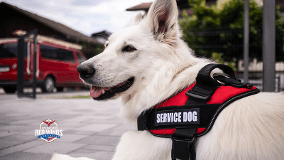When you see a dog in a harness or wearing a vest, it’s easy to assume it’s there to provide emotional support. But not all working animals are the same. There’s a significant distinction between service dogs and emotional support animals (ESAs), and understanding this difference is crucial—especially for Veterans, individuals with disabilities, and the general public.
Let’s break it down and get to the heart of why service dogs are assistive devices, not pets, and why respecting their role is non-negotiable.
What Are Service Dogs?
A service dog is a highly trained working animal that performs specific tasks directly related to an individual’s disability. These tasks are designed to mitigate the effects of the disability and allow the individual to navigate daily life more safely and independently.
Service dogs are covered under the Americans with Disabilities Act (ADA), which means they are legally allowed to accompany their handler in public spaces where pets are not permitted. This includes restaurants, airplanes, stores, and other public venues.
Examples of Task Training
- For Veterans with PTSD: Interrupting flashbacks, waking from nightmares, or providing a buffer in crowds.
- For those with mobility issues: Picking up dropped items, opening doors, or providing balance assistance.
- For those with diabetes or seizures: Alerting to low blood sugar levels or impending seizures.
Key Point: A service dog is not there for companionship—it’s an assistive device, like a wheelchair or a prosthetic limb. They are necessary for their handler’s well-being and independence.
What Are Emotional Support Animals (ESAs)?
An emotional support animal provides comfort and companionship but is not trained to perform specific tasks related to a disability. ESAs can be incredibly helpful for individuals dealing with anxiety, depression, or other mental health challenges, but they do not meet the same criteria as service dogs.
Key Differences:
- No Task Training: ESAs are not required to perform specific disability-related tasks.
- Limited Legal Protections: ESAs are not covered under the ADA and do not have the same rights to access public spaces. Their access is typically limited to housing and, in some cases, air travel.
Why This Distinction Matters
While ESAs serve a purpose, the growing misuse of “emotional support animal” designations has caused significant issues for people with legitimate service dogs. Fraudulent ESAs can:
- Distract or interfere with service dogs in public spaces.
- Undermine public trust in working animals.
- Create confusion about the legal rights of service dog handlers.
If you’re not sure whether an animal is a service dog, remember: a service dog is trained to work, not just be present.
How to Interact With Service Dogs and Their Handlers
If you encounter a service dog in public, here are a few things to keep in mind:
1. Respect Their Space
Service dogs are working, even if it doesn’t look like it. Distracting them could put their handler at risk. Don’t touch, call, or try to interact with the dog.
2. Don’t Ask Personal Questions
It’s inappropriate to ask someone about their disability or why they have a service dog. Respect their privacy.
Under the ADA, the only questions you can legally ask are:
- Is the dog a service animal required because of a disability?
- What tasks is the dog trained to perform?
3. Don’t Pet the Dog Without Permission
Always ask the handler first. Petting a working dog without permission is like grabbing someone’s crutch or wheelchair.
4. Keep Your Pets Under Control
If you have a pet, ensure it’s leashed and under control around service dogs. Aggressive or poorly behaved pets can disrupt a service dog’s work and create dangerous situations.
5. Don’t Assume All Disabilities Are Visible
Not every disability is obvious. Many service dog handlers deal with invisible disabilities like PTSD, epilepsy, or diabetes.
Why Service Dogs Are a Lifeline
For many, a service dog is more than just an animal—they’re a lifeline. They provide independence, safety, and support in ways that no human or device could replicate. These dogs go through rigorous training to meet the highest standards and should always be treated with the respect they deserve.
Final Word
Service dogs are not pets. They are necessary, trained professionals who enable their handlers to live fuller, more independent lives. Emotional support animals, while helpful in their own right, do not hold the same role or legal protections.
So next time you see a service dog, remember: Respect the dog, respect the handler, and understand the difference. It’s not just about kindness—it’s about ensuring that those who depend on service dogs can continue to live their lives without unnecessary obstacles.






